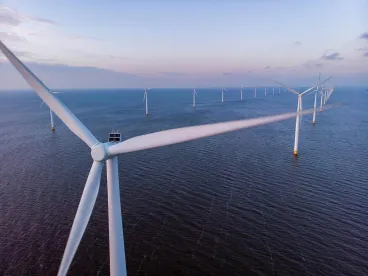The eyes of the offshore wind sector are turning with excitement to the west coast of the United States today as the Bureau of Ocean Energy Management (BOEM) conducts a scheduled mock auction for the Morro Bay and Humboldt Call Areas leading into the live auction tomorrow, December 6th.
Lease auctions for offshore wind areas in the U.S. always generate excitement. Given the dollar figures involved, the scarcity of available areas and the general global and domestic buzz around the sector, this is perhaps not surprising. However, while excitement is building, there is also much uncertainty around potential outcomes.
While all previous offshore lease auctions in the U.S. have been impacted by myriad factors, it would be difficult to conceive of a situation with more rapidly developing, and oft conflicting, data points than bidders face heading into the California auction. Previous lease prices, macroeconomic conditions, recent federal legislation, new non-monetary credit approaches and technological changes are all factors that bidders will grapple with in determining bid strategies and caps. Here, we explore some of the factors that bidders are analyzing ahead of tomorrow’s auction.
Potential Positive Drivers of Pricing in California
Previous Auctions
2022 has been a busy year for auctions, with two being held on the east coast earlier this year. The first, for five areas in the New York Bight Call Area, represents the current high-water mark in the U.S. with respect to both participation (25 qualified bidders) and pricing with one area crossing the $1B mark and the auction garnering over $4.3B in total. Indeed, the approximately $9,000/acre pricing in New York led some to query whether lease values were becoming divorced from project values and leases themselves viewed as fungible assets rather than as cost inputs in broader project return models.
The second auction held this year afforded bidders the opportunity to bid on two areas in the Carolina Long Bay Call Area. While pricing in these areas did not match what was seen in New York, there were both technical factors as well as legislative uncertainty around the ability for non-utilities to own operating projects that market observers agree limited the upside. Despite these overhangs, pricing on the two areas in the Carolina Long Bay area still reached over $2,800 per acre.
Given the relative lack of data points in the offshore wind market, previous lease prices are certainly a factor bidders consider when developing bid models. Using Carolina Long Bay and Bight per acre pricing would indicate that the approximately 373,000 acres available in the California auction would be worth between $1.04B (Carolina pricing) and over $3.3B (on a Bight basis).
However, some market observers question if the impact of Bight and Carolina Long Bay pricing on the California auction may be muted as there are market conditions at play, as further discussed below, that could prove more impactful on bidding than simple proxies. Nonetheless, bidders should not discount that previous prices in a market with scarce opportunities could drive value in subsequent auctions, particularly with eager new market entrants among bidders.
Number of Qualified Bidders
While the Bight auction holds the record for qualified bidders at 25, the California auction has surpassed that, with 43 entities listed as qualified bidders in the Final Sale Notice for the areas. This doesn’t mean that all 43 entities will bid, but it does potentially increase the probability that there will be more bidders than areas available, which will increase the odds of higher prices.
The high interest also leads to the possibility of joint bids, which were both prevalent and drove pricing in the New York auction earlier this year. While a project at some point must reach a return threshold, a prospect which is negatively impacted by higher costs incurred for leasing, it is also true that partnerships reduce upfront capital commitments and reduce risk for individual entities, which has the ability to push pricing up.
The number of potential participants also increases the odds that there will be participants who will be ‘bidding to win’ separate from some of the fundamental factors noted herein. Even self-professed ‘disciplined’ investors will account for variability of a large number of participants with bid caps based on upside scenarios, all of which could see a protracted auction process with prices higher than some expect.
The Inflation Reduction Act
The Inflation Reduction Act has addressed some timing issues related to the Investment Tax Credit (ITC) that previously existed for offshore wind projects, assuming certain requirements are met. It has also renewed the ability of owners to claim Production Tax Credits (PTCs) at full value. More certainty on the availability of tax credits at points in time and options around the form of tax credits that can be taken can be seen on their face as beneficial to the industry and a potential source of upward pressure on bids.
However, certain requirements of the IRA may cause bidders to be cautious about the value attributable to credits. While the IRA includes some value creators for offshore wind, many market observers have noted that, over certain time periods, the IRA will likely cause pricing uncertainty at the least, and potentially economic and timing drags on projects due to the supply constraints that could arise on labor (to obtain full credits) and domestic produced content (for 10% adders). Some offshore wind observers have also commented that it is unclear whether certain domestic content requirements will be able to be met at any price given the current state of offshore wind infrastructure in the U.S.
Therefore, while the IRA could be viewed as a value-driver, bidders may be cautious and are likely to risk-adjust potential benefits for the factors noted above in their bid models.
Potential Drags on Pricing in California
Macroeconomic Factors
Macroeconomic factors may prove to be the most impactful negative stimulus on bids in the California auction. The renewable energy sector, like nearly every sector of the global economy in the aftermath of the Coronavirus pandemic, faced supply chain delays. Certain supply chain issues could be exacerbated by domestic content provisions of the IRA as noted above.
Rising interest rates are also sure to be a factor as costs of financing are calculated. While financing decisions on California projects are years away, it is also true that interest rate curves being used by bidders will necessarily look different than they did mere months ago. On projects with bond-like returns, those financing costs can be hugely impactful.
Inflation could also prove to be a factor. Steel provides a recent example. The conflict in Ukraine initially caused the price of steel to rise by nearly $500 per ton. While the price has since fallen it is likely that such recent data points will be reflected in bidder models. In addition, the cost to transport steel and other raw materials could further stretch an already weakened supply chain.
Technological Factors
The California auction will be the first time federal waters deep enough to require floating technology will be auctioned in the U.S. While there are floating arrays globally, the current state of technology has not caught up to the turbine sizing most market participants assume (20MWs). Given the lack of local supply chain, needed technological advances and cost uncertainty, the need for floating technology for California projects will also likely create downward pressure on bids.
Multi-Factor Bidding
It is unclear whether, and how, bidders will utilize the new non-monetary credit approach that was rolled out by BOEM for the California auction. It is also unclear how claimed commitments might be reflected in bids. While in some cases the types of actions bidders are getting credit for were likely already assumed in bid models prior to final BOEM guidance being provided, bidders assuming cash outlays, particularly if expenditures must be made earlier in time than may have otherwise been the case, seems like it is more likely than not to decrease cash bids for leases.
Conclusion
It only takes two dedicated bidders to run prices up to the eye-catching levels seen in the Bight auction. Given the number of potential bidders in the California auction, including eager prospective market entrants, the possibility of a race to Bight valuations can’t be entirely discounted. As BOEM posts bid information online, observers will be able to watch motivated bidders setting the high water mark in near real-time.
However, given market conditions and other factors noted above, BOEM (which set expected bounds in the auction between $400M and $1.6B in its Decision Memorandum of October 12) and many market observers believe that per-acre pricing in California is likely to be between the values recently seen in North Carolina and New York leaving Bight as the U.S. leader in per acre pricing for the foreseeable future.
Joshua Sturtevant also contributed to this article.




 />i
/>i

